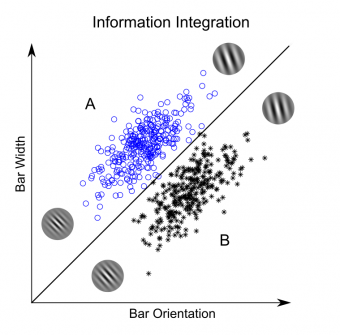
Category Learning
Dr. Ashby was among the first researchers to propose that human category learning is mediated by multiple systems (Ashby, Alfonso-Reese, Turken, & Waldron, 1998, Psychological Review). Prior to 1998, when he proposed the multiple-systems theory called COVIS, the virtually universal view was that people have one category-learning system that they use to learn all types of categories. In many articles published since then, he has reported empirical evidence supporting the view that human category learning is mediated by multiple systems.
In 2005, he extended this work with his proposal that human learning in general is mediated by multiple systems and that these systems map onto the major memory systems that have been identified by memory researchers (Ashby & O’Brien, 2005, Trends in Cognitive Sciences). Today, almost all researchers acknowledge that humans have multiple learning and memory systems.
To investigate these different learning systems, Dr. Ashby developed matched tasks called rule-based (RB) and information-integration (II) category-learning tasks that have now been used in hundreds of published articles. RB and II tasks use the same stimuli and can be equated exactly on almost all category-separation statistics, yet the evidence is good that they recruit different memory systems. For example, at least 30 different empirical dissociations between RB and II learning and performance have now been reported (many from Dr. Ashby's lab). These dissociations were virtually all predicted a priori by COVIS (i.e., in a parameter-free fashion) and collectively they provide strong support for the theory that RB learning depends on declarative memory and II learning depends on procedural memory.
Dr. Ashby has also been a world leader in identifying the neural basis of human category learning. His 1998 article proposed COVIS as the first neuroscience-grounded theory of category learning. Before that, all categorization theories were strictly cognitive. COVIS has been refined over the years, but its basic tenets have been supported in hundreds of published articles – namely that RB learning is mediated by a broad network that includes prefrontal cortex, anterior cingulate, the head of the caudate nucleus, and medial temporal lobe structures, while II learning depends on the striatum and premotor cortex.
In 1999, Dr. Ashby proposed a detailed neurobiological theory of the influence that positive mood has on categorization, and more generally on cognition (Ashby, Isen, & Turken, 1999, Psychological Review). This was the first paper to tie cognitive effects of positive mood to dopamine (now a widely accepted view), and it was one of the first papers in the burgeoning new field of social neuroscience.


